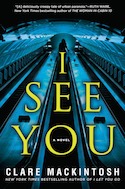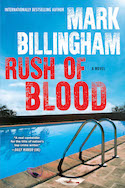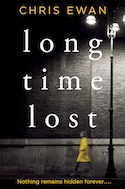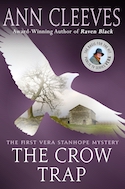Criminal Fiction: Scottish Noir and books galore
Every month, Daneet Steffens uncovers the latest goings on in mystery, suspense, and crime fiction. See previous columns on the Criminal Fiction archive page
This weekend sees the inaugural Granite Noir crime fiction festival in Aberdeen, Scotland (February 24 – February 26). Heavy-hitters such as Stuart MacBride, Chris Brookmyre, Doug Johnstone and Denise Mina are just some of the featured writers participating in conversations, panels, workshops, film screenings, a special Noir at the Bar and — I particularly like the sound of this one — an afternoon discussing Agatha Christie’s favorite poisons.
Granite Noir offers a distinctly Scottish crime fiction flavor, nicely infused with touches of Nordic noir. If you’re not based in the Scotland’s Granite City, you can still follow some of the fun via Facebook and Twitter
Reading around: new titles on the crime fiction scene

I See You by Clare Mackintosh (Berkley) whose super-chilling psychological thriller I Let You Go was one of the creepiest of last year’s creepy crop, returns with a vengeance and an on-the-pulse tale of our real-life vulnerabilities when it comes to others’ nefarious digital activities. The novel kicks off with one Zoe Walker finding her own face illustrating a classified ad for the intriguingly named “FindTheOne.com” site, and veers into the “don’t-read-this-alone-in-the-house-at-night” stratosphere from there.

River Cartwright, a British spy based in Slough House – the dead-end office where disgraced MI5 agents are relegated to their final desk jobs – is off to visit his grandfather, former spy David Cartwright, who appears to be succumbing to old-age memory loss and ramblings. Not so reassuring for other spooks. Mick Herron’s terrific intelligence agents thriller series – this one, Spook Street (Soho), is installment number four – manages to be gritty and slick at the same time, and it’s a real pleasure to watch the super-smart if damaged Slough House agents rising to the occasion once again.

In Mark Billingham’s Rush of Blood (Atlantic), three British couples meet semi-cute on a Florida vacation, a vacay that’s marred on the last day when a young girl, unrelated to them, disappears. Back home, the six Brits stay in touch, meeting up for drinks and dinners while cops pursue the Florida mystery as well as a similar one in England. As he did in his previous standalone, 2016’s Die of Shame, Billingham does a tantalizing job of centering the smoothly paced tension around a small group of characters; and, as he did in Die of Shame, Billingham regular DI Tom Thorne makes a tiny but tenacious cameo.

If you like your thrillers to encompass a relentless chase across Europe, then Chris Ewan’s Long Time Lost (Minotaur) is for you. Nick Miller provides a very particular kind of service, relocating people in trouble with baddies to safer spaces with new identities. But with the addition of his latest client going to ground to hide from a very dangerous man, Miller’s entire network is suddenly under threat – especially as more than one element isn’t quite what they seem to be at first glance.

Ann Cleeves’s The Crow Trap (Minotaur) marks DI Vera Stanhope’s first appearance, back when the novel was meant to be a standalone mystery rather than the start of a series that’s going gangbusters 30 years later –not to mention being the basis of a current hit TV series. Three women gather in a small cottage in rural Northumberland to conduct an environmental survey, but it’s the pileup of dead humans that soon becomes their focus. The suspenseful story is beautifully paced and a welcome affirmation of precisely why – and how invasively – Stanhope got under Cleeves’s skin.
The Quintessential Interview: Kathleen Kent
Kathleen Kent, a bestselling historical novelist, turns her trusty pen to contemporary crime fiction in The Dime, a rollicking police procedural set in Dallas, Texas. Brooklyn transplant Betty Rhyzyk, refreshingly engaging and a committed detective with the canny voice of her tough-cop uncle a comforting – and life-saving –presence in her head, finds herself colliding with plastic-surgeried women, Mexican drug runners, Confederate re-enactors, religious fundamentalists, and, in a terrifically entertaining scene, an errant armadillo.
What or who are your top five writing inspirations?
Often, my inspiration for writing future projects will come while doing research on a current one. I’ll come across something odd or notable and it will go into my “ideas” notebook. The top five inspirational sources for writing would be newspaper articles (past or present), traveling, reading books of every genre and every possible subject, listening to music, and talking to old people. Old people have the best stories, and are usually very eager – and grateful – to talk about their lives and experiences.
Top five places to write?
My favorite place to write is at my desk, but I also relish writing in bed, on a train, on my patio when the weather is kind, and, sometimes, at a picnic table in a deserted park.
Top five favorite writers?
This is such an incredibly hard question, because there are so many wonderful writers in so many different genres, but I’ll go back to the writers that I’ve read more than once: Cormac McCarthy (Americana/Western), James Lee Burke (Crime), John le Carré (Spy/Mystery), Erik Larson (Non-fiction) — and now I’m going to cheat here because: Harper Lee, Toni Morrison, Margaret Atwood, Annie Proulx, Alice Walker, Barbara Kingsolver and many more….
Top five tunes to write to?
Music is very inspirational to me for setting the mood and narrative voice. While I wrote my first two novels, set in 17th century New England (The Heretic’s Daughter and The Traitor’s Wife), I listened to a lot of Celtic and Ye Olde English music, played on primitive instruments. My third novel was set in 1870 Texas, so I listened to Americana folk/country music, which, interestingly, has a strong Celtic influence as well. For The Dime, I made several playlists to inspire the action. My top five songs from the playlists are Bang, Bang, Bang by Dorothy; Back in Black by Brother Strut, featuring Lorna Fothergill; Conman Coming by Monica Heldal; Glory Box by Portishead; and Bad Things by Emilie Bouchereau.
Top five hometown spots?
Deep Ellum, for its restaurants and music clubs; the Bishop Arts District, for its home-grown craft stores, art galleries and indie bookstore, The Wild Detectives; Addison, north of central Dallas, for its fantastic assortment of Asian restaurants; Klyde Warren Park, for its public green areas, and nearby Dallas Museum of Art and the Nasher Sculpture Center; Trinity Groves, for its long pedestrian bridge crossing the Trinity River, walking trails and spectacular view of the Margaret Hunt Hill Bridge.